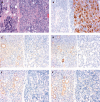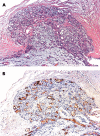Mucin expression in pleomorphic adenoma of salivary gland: a potential role for MUC1 as a marker to predict recurrence
- PMID: 15280401
- PMCID: PMC1770389
- DOI: 10.1136/jcp.2003.014043
Mucin expression in pleomorphic adenoma of salivary gland: a potential role for MUC1 as a marker to predict recurrence
Abstract
Background: Pleomorphic adenoma of the salivary gland (PA) is essentially a benign neoplasm. However, patients with recurrent PA are difficult to manage. There are rare reports on useful immunohistochemical markers to detect a high risk of recurrence when the primary lesions are resected.
Aims: To find a new marker to predict the recurrence of PA.
Methods: Primary lesions of PA were collected from nine patients showing subsequent recurrence and from 40 patients without recurrence during at least 10 years of follow up of the disease. Paraffin wax embedded tumour samples of the two groups were examined for the expression profiles of MUC1 (differentially glycosylated forms), MUC2, MUC4, MUC5AC, and MUC6 using immunohistochemistry. Several clinicopathological factors were also examined.
Results: In univariate analysis of the factors examined, MUC1/DF3 high expression (more than 30% of the neoplastic cells stained) in the primary lesions was seen more frequently in patients with recurrence (four of nine) than in those without recurrence (three of 40; p = 0.011). Larger tumour size (more than 3.0 cm) of the primary PA was also a significant (p = 0.035) risk factor for the recurrence of PA. In multivariate analysis, only high expression of MUC1/DF3 was found to be a significant independent risk factor for the recurrence of PA (p = 0.021).
Conclusions: Expression of MUC1/DF3 in PA is a useful marker to predict its recurrence. Those patients with PA showing positive MUC1/DF3 expression should be followed up carefully.
Figures


Similar articles
-
Expression of membrane-bound mucins (MUC1 and MUC4) and secreted mucins (MUC2, MUC5AC, MUC5B, MUC6 and MUC7) in mucoepidermoid carcinomas of salivary glands.Am J Surg Pathol. 2005 Jun;29(6):806-13. doi: 10.1097/01.pas.0000155856.84553.c9. Am J Surg Pathol. 2005. PMID: 15897748
-
Intestinal metaplasia of human stomach displays distinct patterns of mucin (MUC1, MUC2, MUC5AC, and MUC6) expression.Cancer Res. 1999 Mar 1;59(5):1003-7. Cancer Res. 1999. PMID: 10070955
-
Immunohistochemical expression of mucin antigens in gallbladder adenocarcinoma: MUC1-positive and MUC2-negative expression Is associated with vessel invasion and shortened survival.Histol Histopathol. 2017 Jun;32(6):585-596. doi: 10.14670/HH-11-824. Epub 2016 Sep 27. Histol Histopathol. 2017. PMID: 27672051
-
Recent advances in mucin immunohistochemistry in salivary gland tumors and head and neck squamous cell carcinoma.Oral Oncol. 2011 Sep;47(9):797-803. doi: 10.1016/j.oraloncology.2011.06.008. Epub 2011 Jul 1. Oral Oncol. 2011. PMID: 21723776 Review.
-
Significance of mucin expression in pancreatobiliary neoplasms.J Hepatobiliary Pancreat Sci. 2010 Mar;17(2):108-24. doi: 10.1007/s00534-009-0174-7. Epub 2009 Sep 29. J Hepatobiliary Pancreat Sci. 2010. PMID: 19787286 Review.
Cited by
-
Management and prognostic factors of recurrent pleomorphic adenoma of the parotid gland: personal experience and review of the literature.Eur Arch Otorhinolaryngol. 2008 Apr;265(4):447-52. doi: 10.1007/s00405-007-0502-y. Epub 2007 Oct 25. Eur Arch Otorhinolaryngol. 2008. PMID: 17960409 Free PMC article.
-
A mucoadhesive in situ gel delivery system for paclitaxel.AAPS PharmSciTech. 2006 Jun 2;7(2):E53. doi: 10.1208/pt070253. AAPS PharmSciTech. 2006. PMID: 16796370 Free PMC article.
-
Development of human minor salivary glands: expression of mucins according to stage of morphogenesis.J Anat. 2011 Sep;219(3):410-7. doi: 10.1111/j.1469-7580.2011.01405.x. Epub 2011 Jun 16. J Anat. 2011. PMID: 21679184 Free PMC article.
-
Molecular cytogenetic pilot study on pleomorphic adenomas of salivary glands.Oncol Lett. 2020 Feb;19(2):1125-1130. doi: 10.3892/ol.2019.11198. Epub 2019 Dec 10. Oncol Lett. 2020. PMID: 31966040 Free PMC article.
-
Pleomorphic Adenoma in the Lower Lip: A Case Report and a Review.Eur J Dent. 2019 Oct;13(4):649-653. doi: 10.1055/s-0039-1700363. Epub 2019 Nov 13. Eur J Dent. 2019. PMID: 31724141 Free PMC article.
References
-
- Buchman C, Stringer SP, Mendenhall WM, et al. Pleomorphic adenoma: effect of tumor spill and inadequate resection on tumor recurrence. Laryngoscope 1994;104:1231–4. - PubMed
-
- Henriksson G, Westrin KM, Carlsoo B, et al. Recurrent primary pleomorphic adenomas of salivary gland origin: intrasurgical rupture, histopathologic features, and pseudopodia. Cancer 1998;82:617–20. - PubMed
-
- McGurk M, Renehan A, Gleave EN, et al. Clinical significance of the tumour capsule in the treatment of parotid pleomorphic adenomas. Br J Surg 1996;83:1747–9. - PubMed
-
- Natvig K, Soberg R. Relationship of intraoperative rupture of pleomorphic adenomas to recurrence: an 11–25 year follow-up study. Head Neck 1994;16:213–17. - PubMed
-
- Phillips PP, Olsen KD. Recurrent pleomorphic adenoma of the parotid gland: report of 126 cases and a review of the literature. Ann Otol Rhinol Laryngol 1995;104:100–4. - PubMed
Publication types
MeSH terms
Substances
Grants and funding
LinkOut - more resources
Full Text Sources
Medical
Research Materials
Miscellaneous
